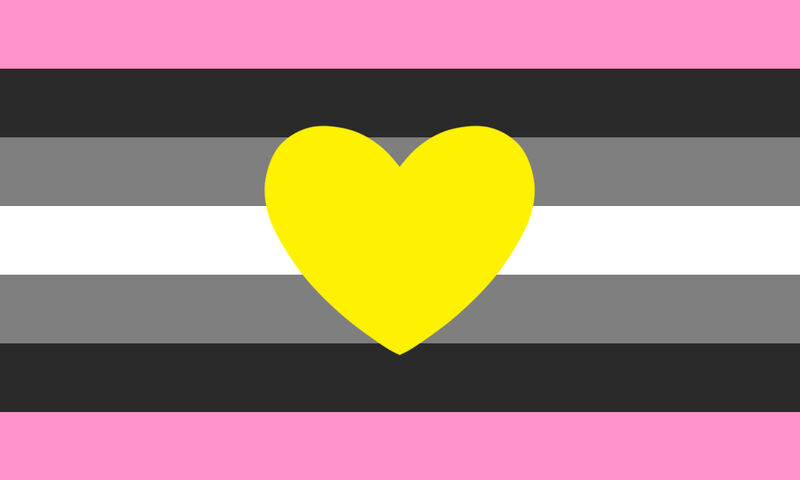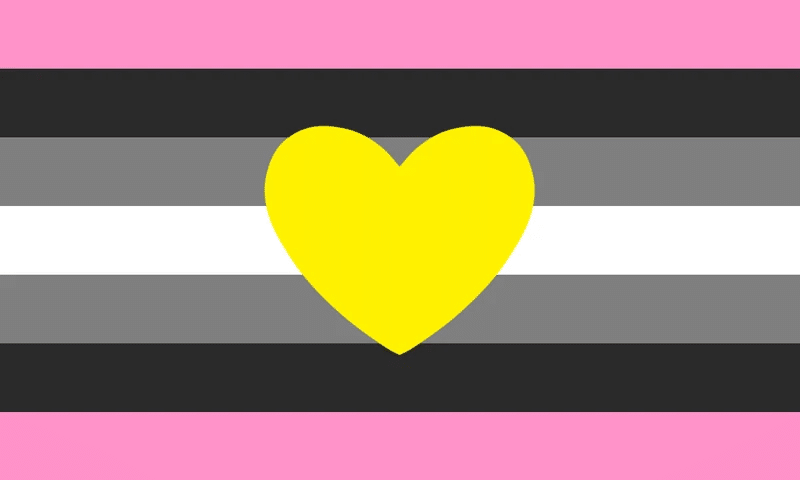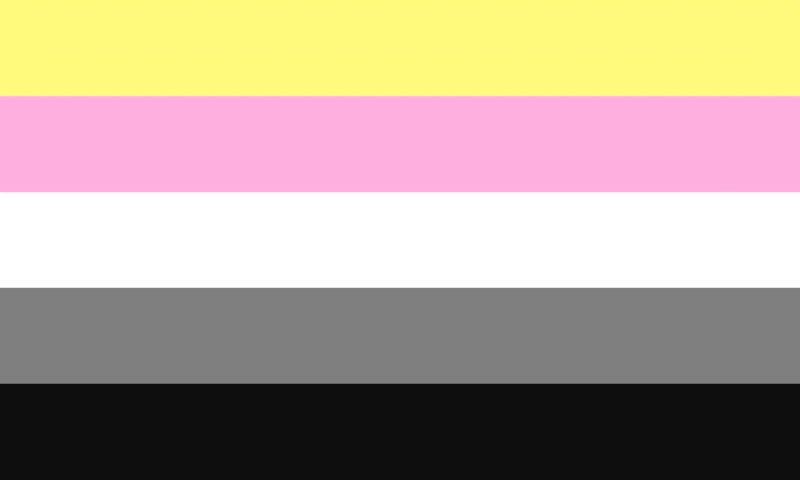Queerplatonic Relationship – What is it? What does it mean?
 Queerplatonic relationship flag
Queerplatonic relationship flag
Queerplatonic typically refers to a relationship that bends the lines between a romantic relationship and a non-romantic relationship. A queerplatonic relationship (QPR) often goes beyond what is socially acceptable for a platonic relationship but does not fit the typical notion of a romantic relationship.
Queerplatonic may also refer to a form of tertiary attraction for a-spec individuals. The queerplatonic attraction may be very similar to a platonic attraction for some but for others, it may have a very clear distinction. People who experience queerplatonic attraction often describe it as being stronger and more intimate than purely platonic attraction.
Table of Content
Queerplatonic typically refers to a relationship that bends the lines between a romantic relationship and a non-romantic relationship. Queerplatonic relationships (QPR) often go beyond what is socially acceptable for platonic relationships but do not fit the typical notion of a romantic relationship.
Terminology
Queerplatonic may also refer to a form of tertiary attraction for a-spec individuals. The queerplatonic attraction may be very similar to a platonic attraction for some, but for others it may have a very clear distinction. People who experience queerplatonic attraction often describe it as being stronger and more intimate than purely platonic attraction – an emotional connection that goes beyond “just friends” or even “best friends.”
According to WordSense Dictionary, the term queerplatonic is an adjective that combines the term queer and platonic. The best way to properly describe queerplatonic couples is they closely resemble romantic partners and two friends but do not fit the general idea of extremely close friendships or romantic relationships with someone.
If referring to a queerplatonic relationship it can be defined as:
“Not romantic or sexual relationships but sharing a stronger emotional bond than typical of friendship.”
It is important to note that a queerplatonic relationship may also be the term to describe non-romantic relationships. A queerplatonic relationship is sometimes shortened to QPR. There are several other names for it as well. They may all be used to identify a queerplatonic partnership.
- Quasiplatonic relationship
- QPR
- Quirkyplatonic relationship
- Qplatonic relationship
Since queerplatonic relationships are practiced by partners who are asexual and/or aromantic people, the words boyfriend/girlfriend or partner or even significant other do not fit queerplatonic partnerships. That’s why the terminology had to evolve and create its own labels for a partner like:
Squish, Plush and Squash: in other words a QPR crush. The terms characterized someone to have an intimate connection with but outside the nature of a traditional intimacy or romance. So a crush who may eventually become a SO but not in a heteronormative way of attraction or feelings.
Zucchini: this term started out as a joke in the a-spec community to refer to partners. It quickly became a label to describe a queerplatonic partner.
If you want more information about the a-spec community (asexual and aromantic), there are a wealth of books on the subject on the Jessica Kingsley Publishers website, written by a variety of knowledgeable authors.
How and Why the Term Originated – The History
Henry James was a prolific author in 19th century. In 1886, he published The Bostonians, a serial novel in a local magazine. The heroine, Verena, is torn between her male suitor and Olive, a feminist and her mentor. Ultimately, she chose Verona, and the two became what is now called queerplatonic partners. At the time, such a relationship was termed a “Boston marriage,” more than a friendship, less than a romance.
The idea of two women pooling their resources and forming a household together was not new, even in the 19th century, though that was the beginning of asexual communities and aromantic communities of women who chose to live together, sharing their resources and responsibilities.
Perhaps the earliest of these non-romantic intimate partnerships was described in the Old Testament of the Bible. Naomi lost her husband and both of her sons. Her daughter-in-law Ruth, against Naomi’s initial advice, decided that they both needed emotional support, could pool their resources, and go back to Naomi’s birthplace to live together. Obviously, the relationship wasn’t romantic or sexual – a platonic relationship that benefitted them both.
19th Century Queerplatonic Attraction
But by the 1800’s, women who wanted to be independent and in charge of their own property and lives, knew they could not marry because of coverture laws. These laws subjugated women to their husbands, so that any assets or resources they had belonged to their husbands. Wealthy women who wanted independence found that forming non-romantic partnerships with other women gave them a best friend, a strong emotional connection, and freedom. And during this time aromantic and asexual communities sprung up, based on just friendship of the members – significant relationships of shared resources and responsibilities, such as co-parenting, for the good of the whole. The attraction of queerplatonic lifestyles was clear and obvious to these women.
Coining a New Term for People Involved in Queerplatonic Lifestyles
In the 19th century, people involved in platonic such associations were seen as engaging in “relationship anarchy,” though that term was not used until the 20th century, when it was coined by Swedish activist Andie Nordgren. Relationship anarchy refers to meaningful relationships that are formed by people outside of the “norms” of society, based upon people involved in those relationships making up their own rules. Thus, the individuals involved can forge the boundaries of their own partnerships that are not necessarily romantic, nor must they involve physical intimacy. Queerplatonic relationships fall under this umbrella, of course.
20th Century Brings a New Term for Platonic Love Relationships
The terminology around queerplatonic relationships was first documented in 2010 in an online thread called Kaz’s Scribblings. Since the phrase queerplatonic originated in late 2010, by the time 2011 rolled around, it quickly gained popularity among online users.
It described an aromantic form of a connection with someone that was outside the boxes of friendship and/or romance. In spring 2014, the phrase quasiplatonic relationships was coined for a-spec people who were uncomfortable with using the word queer. These individuals have friendships that are non-romantic and are platonic relationships instead. There is an intimacy, of course, but there are not sexual or romantic feelings in our normal understanding of the terms.
Where Queerplatonic Relationships Stand Today
So here we are well into the 21st century. And here are the key factors of queerplatonic lifestyles.
- They are very close relationships, more than a conventional friendship
- They are not romantic or sexual relationships
- People of any gender identity or sexual orientation may form these. They may be lesbians, heterosexuals, gays, asexual, aromantic, even trans people. In fact, there may be an invisible orientation, as that does not matter.
- They may begin as a close friendship and evolve into an unromantic romantic and a non-sexual relationship
- The relationship may involve rejection of the nuclear family concept in favor of mutual parenting of children involved.
- Partners may be physically affectionate, as close friendships often are. But such affection is non-sexual.
- They may come as the result of the end of some other relationship that died, where sexual relations and romantic love were involved, and that individual has now found that a platonic partnership is what they have really wanted all along.
- People who experience queerplatonic attraction can be cisgender, transgender, or anywhere else on the LGBTQ+ spectrum. They are most frequently within the asexual and aromantic spectrum but that does not mean they have to be. Their emotionally close relationship with someone does not involve the normal forms associated with desire and attraction.
- A person also does not have to identify as asexual, aromantic, genderqueer, gay or any other level to be in a queerplatonic relationship. That said, people may use a variety of gender-specific pronouns like he/him or she/her as well as gender-neutral pronouns like they/them or ze/zir. They may also prefer to not use pronouns at all and ask to use their name instead.
- It is important to always share your pronouns and ask a person about their preferred pronouns in conversation. Never assume someone’s pronouns based on their sexual or romantic attraction, orientation, or gender expression.
Now that you understand the difference between sexual, romantic and platonic relationships, it’s time to check out some other aspects of queerplatonic relationships
Flag and Symbols
There are several variants of the queerplatonic flag available online. At least four different designs have the same color scheme of pink, yellow, and grey, although there are now a host of other colors schemes.
All of the flag designs feature a large yellow heart in the middle. Sometimes that yellow heart has an infinity sign superimposed on it. In all designs, that yellow heart stands for queerplatonic connections. The other stripes refer to others who experience queerplatonic attraction. For example, there is a polyamory queerplatonic flag that looks like this:
 Most commonly used queerplatonic flag
Most commonly used queerplatonic flag
The yellow stands for platonic connections. Pink symbolizes romantic attraction and grey symbolizes everyone on the a-spectrum.
Pronouns
People who experience queerplatonic attraction can be cisgender, transgender, or non-binary. They are most frequently on the asexual and aromantic spectrum but that does not mean they have to be. Their emotionally close relationship with someone does not involve the normal forms associated with desire and attraction.
A person also does not have to identify as asexual, aromantic, genderqueer, gay, or any other level to be in a queerplatonic relationship. That said, people may use a variety of gender-specific like he/him or she/her as well as gender-neutral pronouns like they/them or ze/zir. They may also prefer to not use pronouns at all and ask to use their name instead.
It is important to always share your pronouns and ask a person about their preferred pronouns in conversation. Never assume someone’s pronouns based on their sexual or romantic attraction, orientation, or gender expression.
How to Know if You in a Queerplatonic Relationship?
In today’s society, there are many boxes romantic relationships have to fit in. Think about the hard lines for behavioral norms when it comes to friends or romantic relationships. People are expected to act a certain way with acquaintances and romantic partners. Queerplatonic partners blur those lines.
QPRs are often seen as having a different level of emotional closeness and attraction. Some queerplatonic relationships may resemble a traditional definition of a friendship while others may seem more like a romantic partnership. For example, some people live in the same house, create major life activities together or develop a so-called family unit.
There may even be a form of physical affection involved like handholding, cuddling, kissing, and even having sex. A queerplatonic partner may express desire to get married.
There is no set of rules when it comes to queerplatonic relationships. For some, it involves physical aspects for others it does not. It all depends on what people find fits them best and makes them happy.
Generally, people in QPRs have a deep commitment to one another. For example, many may be considered exclusive partners. They are devoted to their connection and show commitment to life-planning that may be different from traditional ways of a romantic relationship but fit a queerplatonic relationship.
How to Support Queerplatonic Relationships?
The fact of the matter is to throw expectations out of the door. Whatever you feel or believe a partnership should be is quite frankly your feeling, not the other person’s. So, if you desire to showcase your support for a-spec folks who are in queerplatonic relationships, start by doing the following to support the community:
- Research and learn more about QPRs
- Join asexual and aromantic message boards, online groups, and a-spec community forums
- Volunteer at a-spec events
- Get to know people in QPRs, ask appropriate questions, and gather info from the source
It is important to note that the expectations in queerplatonic relationships are not the same as in the typical heteronormative ones. People in QPRs experience different models of partnerships and connections. They break the rules and bend the norms to make their relationship work for them.
QPRs can be a committed long-term monogamous relationships or polyamorous relationships if that works for the people that are in it. The most important thing is not to judge but to listen and offer a helping hand when asked. Do not give advice if you’re not asked for it.
Remember that if you want to show support for LGBTQ+ people including a-spec individuals you may seek out your local LGBTQ+ organizations who work with specific members of the community. Think about your commitment and involvement in issues and why it matters to you.
Also, if you want to be in a QPR, go ahead! Your relationships are yours to claim and you do not have to fit into a box in order to fulfill societal norms and expectations.
Gallery
 An alternate version of queerplatonic flag
An alternate version of queerplatonic flag
Resources
https://www.wikihow.com/Queerplatonic-Relationships
queerplatonic: meaning, translation – WordSense
Queerplatonic Relationships: A New Term for an Old Custom | Psychology Today
Share this post:
What do you think?
 Queerplatonic relationship flag
Queerplatonic relationship flag


